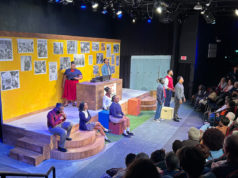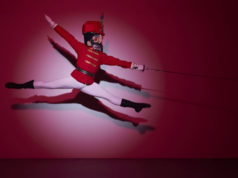Since 2000, Broadway has enjoyed a steady ascent of new musicals, most of which boast original orchestral scores. An American in Paris is a rare modern musical in its adaptation of pre-existing symphonic jazz scores — a few of which can be attributed to George and Ira Gershwin — and as a period piece reluctant to engage in social commentary, even on the conservatism of post-World War II France. Yet this production paved the way for other recently popular musicals, like Hamilton, abetting the ambitions of composers wanting audiences to snack on a little dance, a little song, and a little monologuing in the same show.
Always hungry for a Big Apple production, the Panther City went purring after An American in Paris last week. The show opened on February 14 at Bass Performance Hall, nearly selling every one of the 2,042 seats in the downtown opera house. Adapted from symphonic poem to film in 1951, and then from film to stage in 2014, this production premiered at the Théâtre du Châtelet in Paris, the setting of an early scene in the play. The production made headlines in New York the following spring and began a North American tour last fall before heading to London’s West End later this year.
The play begins with an American in Paris, of course. Well, make that two Americans, leading heartthrob Jerry Mulligan (Garen Scribner) and his quick-with-a-joke compatriot Adam Hochberg (Etai Benson). Both men served in World War II, and both men decided to stay overseas to pursue artistic and romantic passions. Jerry dreams of being a visual artist while Adam makes a name for himself working feverishly on new piano compositions. Dramatic irony ensues as they secretly pine for the same girl, up-and-coming ballerina Lise Dassin (Sara Esty), whose undiscovered talent and secret family history make her the object of affection for Henri Baurel (Nick Spangler), heir apparent to a sizable French fortune. As Lise’s three garçons grow closer as friends, they soon realize their shared lust for the tiny dancer who keeps them all at a comfortable distance. Meanwhile, a boisterous American heiress named Miss Milo Davenport (Emily Ferranti) plays patroness to the ballet theater and takes a strong liking to Jerry. In Act II, every sharp corner of this perfectly Parisian love pentad is uncovered at a celebratory dance reception. Several duets and ensemble performances later, every actor sees forsaken love in a disparate light. If you’ve seen any 1950s romance film, you know how this play ends.
As the narrator, the leading man’s best friend, and the audience’s lovable loser, Benson demonstrated a fine-tuned consistency of character, acting as a foundational agar from which Scribner could leap forth and prance across the stage with all the virility of a male lapdog. The self-righteous tenacity of French frog, Spangler, was equally well-regulated and easy to overlook as his lines added dimension to the relationship between Benson and Scribner but in a way that displayed Spangler’s more obvious character development. Energetically, the apex of the musical peaked in “I’ll Build a Stairway to Paradise,” but there were moments when Spangler’s accent faded while speaking and singing at faster tempos. In contrast, Ferranti’s emotional journey through love, jealousy, and acceptance landed her squarely in the center of this play as the cast’s most affectatious actor.
The difficulty of women’s ballet ensembles is the overly aspirational choreography pursued when contorting feminine features into delicate compositions. Musical theater ensembles, having more moving parts to tend to, frequently aspire to challenging synchronizations, and, with dancers outfitted in spartan attire, the outcome is almost always less forgiving of individual differences between dancers’ frames. This impossibly high standard was nearly met by this ensemble, give or take a few loose arms that came whirling out in attitudes and arabesques, but presented in outstanding measure by prima ballerina Esty. She delivered the best coupé jeté Cowtown has ever seen.
Relatively smooth set transitions were aided by exceptional handling of props between scenes. Period-specific attire made fashionable statements, to be expected in this sort of production, excepting for only one split, a very literal split down the back of Jerry’s pants in Act I. What stood far out in front of the other set design choices was the large animation screen towing the audience through a bevy of new projections: flatiron buildings collided and were pulled apart, windows twinkled with interior light, and a river rippled on what appeared to be a silk screen. This highly stylized visual effect was unlike any other animated projection I’ve seen onstage, a delightful update and another attempt at blurring genre lines, albeit this time between theater and film.
For anyone who’s never been to Broadway, the animation screen will strike wonder into the eyes above all else, including the strength of the ballet ensemble. Undoubtedly, however, the most powerful mode of communication in this play is dance, which will likely appeal more to professionally trained dancers and other performing artists. The emphasis on dance might leave something to be desired for single-threat thespians, who will find the musical to be romantic but not warm without much wordplay. Nevertheless, any hopeless romantic is sure to enjoy the sizzling and singeing of affairs from a production born of the golden age of American film and television.












